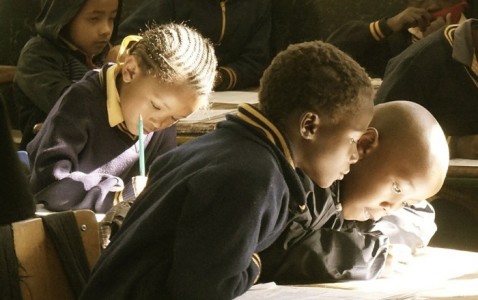Originally published in Teachers & Writers Magazine (1982, Vol. 13, No. 4).
My goal at Hunter College Elementary School was to have each one of the third and fourth-graders I was working with write a novel. Why a novel? Because it’s the monster under the bed for so many writers. Let’s get it out from under there. A novel is the longest structure in fiction writing. Like aspirin, no one knows exactly how it works. It’s a formless, shapeless mass unless infused with the writer’s personality. It also lends itself to episodic form, arranging situations chronologically and/or situationally through chapters. A novel must generate its own internal structure, there are no outside absolute models. How can children approach this overwhelming task? One lesson I’ve learned as a writer is that there’s no ideal structure. Kids (and adults too) can waste a lot of time straining over “perfect” frameworks for their feelings. There are no perfect frameworks, there are only makeshift ones that turn out to work just fine.
During my first few weeks I gave the children short writing assignments, as I usually do in each school. Through this routine I gained some idea of the strengths and weaknesses of individual students, and of the classes as a whole. I found tremendous variance in sheer ability to write, a variance I had to take into account while helping kids with their individual long-term projects. Another reason for beginning with short, easy-to-handle writing assignments was to introduce slowly the sometimes painful solitariness that goes into writing.
Kids in classrooms are aware of each other first and delve into solitariness furtively (usually while the teacher is talking). Each classroom has its own collective mood supporting (or estranging) the class’s individual personalities. That’s why the kids’ verbal interplay at the beginning of a creative writing session can be so important: it focuses that collective personality on a train of ideas and by doing so gives permission to the individual kids in the class to be private for a few minutes and write, without feeling they’re isolating themselves by doing so. The pre-writing discussion is working best if the kids are talking to each other as much as, if not more than, to me. They are watching themselves and, if it’s a good day, are about to enter what Joan Didion called “that room.”
By the end of six weeks most (though not all) of the children had had some experience of entering into that privacy which engenders writing. But the question now was: could they begin to work on their own, without a preliminary public discussion of a group project? How do children provide their own direction for work? Can they generate their own structure without becoming overburdened-terrified-by all that weight? To what extent can eight- and nine-year-old minds plan ahead?
I introduced the planning of the novel’s structure by presenting a “what if” situation. If you were going to write a novel, what would its title be? Keeping this title in mind, what would the names and personalities of the major characters be? And so on: names of five chapters, first and last sentences for the book, one significant conversation-for example, an argument. Can a novel be outlined in fifteen minutes? I think it can, because often in writing it’s over-planning, misused sincerity, that’s the killer. (Over the next week or so a few children did write alternative outlines, which was fine with me.) Virginia Woolf spent seven years writing The Waves; Dostoevsky took ten days to write The Gambler. Woolf had time and Dostoevsky had gambling debts. All good writing is animated by urgency, compounded with playfulness. Over the next few weeks I watched the writing that developed from my announcement: “Ok, now you’ve got the outline for the novel you’re going to write. For the next few weeks you’ll be working on it in class and talking to me about it.”
Every writer deserves a good editor (replacing the depleted supply of patrons); one of the luxuries of this long-term assignment was that I was able to schedule individual conferences with each child. Without using jargon, we talked about plot development, characterization, vocabulary, pacing. How did the child feel about the book? Over and over I found that some kids needed to get specific permission to make changes. The ideal reader is another writer, and I tried to speak with them as writer-to-writer. I pointed out that language’s power lies in its use of specifics; that when in doubt, take what you know from your own life (personal experience works just as well on Mars). I tried to make extra time for kids who were having trouble writing-I didn’t want them to slip between the cracks. Some of these children’s chapters were only a few paragraphs long, but I focused on their developing the stamina to continue a project from one week to the next. With each child, when we finished discussing their creative process, I pointed out a few patterns I noticed, such as problems with grammar, spelling, etc. When the classes finished their books each child bound her or his own book. Many donated their novels to the school library-to be checked out by other kids.
“It is not necessary for a writer to be crazy, but it is useful,” goes the old saying. Most of these children will not grow up to be writers. But whatever profession and idea of themselves they do eventually plot out, I think that learning the art of writing fiction-that most intimate connection between ability and fantasy-is to learn the art of articulating themselves. At the brink of beginning a long piece of writing, any reasonable individual, child or adult, feels an intense desire to flee. But once one begins, as Voltaire noted to Frederick the Great: “What a devil of a profession! But it has its charms.”
Barbara Baracks has written a novel, Pleasure. She also writes short fiction—a story, “Unmentionable Weather,” is appearing in an upcoming issue of MS. She writes journalism and criticism for The Village Voice and other publications.



